Other Fires

Downloadable Guide
There are many different types of fires to construct. Some are more suited for cooking, some for burning overnight, some for warmth.
Star Fire
A star fire is formed by making a small fire and arranging logs around the outside facing inwards to form the points of a star. The logs are fed in lengthwise and be drawn apart to leave glowing embers and ash (for cooking) in the centre. To start the fire going strong again simply push the logs together again.
This type of fire is very useful for conserving fuel. It produces little flame or smoke when required and can be easily 'stoked' by sitting back and pushing one of the logs inwards occasionally.
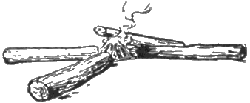
Snake Hole Fire
This is a shielded fire that produces a good draught and can burn almost anything. Find yourself a firm bank of earth and dig yourself a chamber about 45 cm( 18 inches) deep. Drive a stick down into the chamber from above and wiggle it around a little to form a chimney. Remove all the loose earth from inside and build your fire in the chamber.
This is especially useful for burning rubbish.
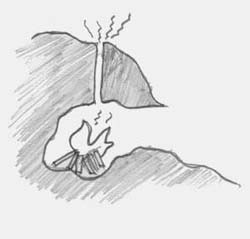
Reflector
A good simple fire. Drive two stout sticks into the ground so that they are leaning backwards slightly. Lay some logs on top of one another against the sloping back. Form a rectangle on the floor at the base of the slope as your fireplace. By lighting a fire in the middle most of the heat will be reflected back to the front of the fire, making cooking easy. Be sure that you build it so the 'grate' or fireplace faces the wind.
A good, solid reflector can be made by driving four uprights into the ground a few inches apart. Then you simply pile sticks in between the uprights to build up a 'wall'. Ideally you will want to fill the space in between with earth.
These walls can be used for a variety of things, here as reflectors but also as dams and shelter walls.
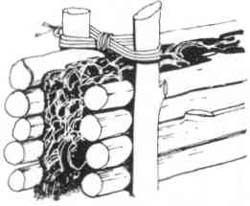
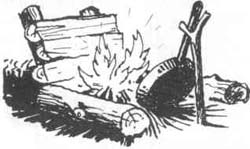
Uses of the reflector fire
In this section I am only interested in using these walls as reflectors.
A good reflector close to the fire will help reflect the heat back towards you. Not only this but it helps to draw the smoke upwards instead of getting in your eyes. You can use this to your advantage by also reflecting heat into your shelter.
Notice when we discussed campfire location I recommended that you did not make a fire up against a large boulder or tree stump. Build the fire away from the rock/stump and place a reflector on the other side. As the rock reflects the heat onto your back, the reflector warms you to the front.
If there are no 'natural reflectors' simply build several reflectors of your own and place one behind you, then one on the other side of the fire.
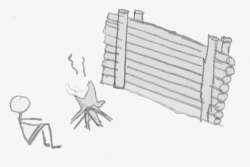

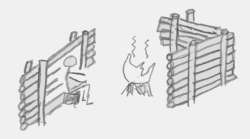
Portable Campfire
by Bob McCartney
We regularly want to use campfire during a meeting but have found them a little time consuming, when I was at a recent course with Cumbria Scouts I was shown a small stove using a shoe polish tin, some wax and Corrugated cardboard. I grew this idea and used a baking tin 20cm Diameter, Four old broken candles and some cardboard box. To make this you melt the candles in your tin under a grill then place many pieces of card upright within the molten wax (Long strips rolled up work best) then allow it to set. You can then light the cardboard which acts like a wick and you get what appears and works just like a small campfire within seconds. You can even use it to cook on. We have used it for lighting when investing new scouts in a forest. It even works after a soaking and once lit does not blow out easily. just have a lid or another tin nearby to extinguish by cutting out the Oxygen.
Indian Fire
by 40th Fife
I have little to say about his myself, not having tried it. It is a useful fire that actually works better in high winds.
I refer you to the excellent explanation at the 40th Fife website